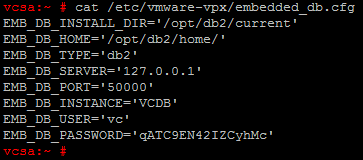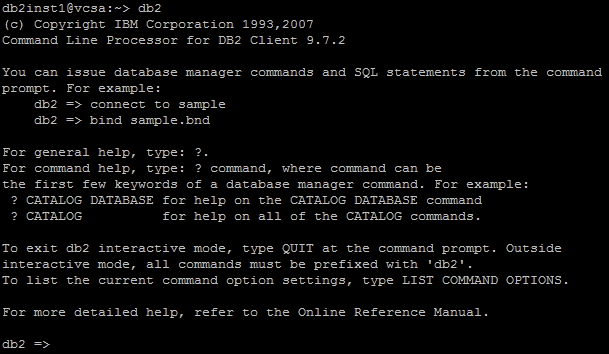vCenter Server Appliance. Part 3 - Managing the embedded DB2 database
In this last post about the vCenter Server Appliance we will see a glimpse on how to manage the embedded database that comes bundle with the vCSA.
First I must say that I AM NOT A DB2 ADMIN. I got this info by playing with the vCSA in my homelab, digging a bit into the DB2 documentation and googling a lot. Use the information provided in this post at your own risk.
If you still want to risk the integrity of your precious appliance please keep reading :-)
“Disassembling” the database installation
Before starting to launch commands against the database we need to know a bit about it. Since this is SuSE Linux check the rpm packages installed.
Now that we now it is DB2 Express version 9.7.2-1, list the files in the package.
This is very interesting, the package doesn’t contain the database but the installation files. The reason for this is very simple, by default DB2 is not installed in the appliance. The Web UI gives you the option to use an Oracle external database or an embedded one.
When you select embedded and click Save Settings is when vCSA starts the installation and configuration of the database. Change to /opt/db2/db2expc_9.7.2_install and look at the contents.
There are four are files, the same showed by the rpm command.
db2exc_972_LNX_x86_64.tar.gz- The DB2 database itself.do_db2_install- The installation script.db2_create_script.sql- SQL script used by the installation script to create the vCenter database and the schema.db2expc.rsp- An answer file used during the installation.
Feel free to take a more detailed look at the files.
Now move to the parent directory, /opt/db2, here you will find the installation directory and two links named current and home. The first will always point to the latest installed version and the second to the home directory for the db2 user. We’ll see more about this user later.
Change to current and the database directory structure will show up. There is a logs symlink, this link point the installation log directory.
The log file is called db2install.history again my advice is to review this log file, along with the installation files it can be a real learning experience about the DB2 installation process.
Identifying the database
OK we know how the database was installed now we need to know how it works. Check for the DB2 processes.
Apart from root there are three other users:
db2inst1db2fenc1dasusr1
Look for these users in /etc/passwd.
The user db2inst1 is the only one who has a login shell, this is the database admin user.
The home directory for the three users is the same that symlink home pointed at in /opt/db2. This is where the DB2 environment is loaded from.
Make yourself db2inst1 to load the DB2 environment. For the majority of the operations we will use the db2 command. db2 is the IBM DB2 Command Line Processor, it runs SQL statements against the database and it can be used in interactive mode, command mode and batch processing mode.
First thing is to know which DB2 version is installed. Use the db2ls command.
As you can see the vCSA is running IBM DB2 9.7.0 FixPack 2. The Install Path is also displayed.
Next is checking DB2 database manager. Use the db2start command to check if the manager is running.
Try to stop the manager with db2stop.
Since the vCenter database is active the operation is not allowed, to force the stop use db2stop force.
Then start again the database manager.
We are going now to get the running instances. There are two commands to perform this operation, db2ilist and db2 get instance.
As you probably know many databases can be created within the same instance so we are going to list the databases created.
As expected only one database is created and its name is VCDB… Surprise!
In a DB2 installation we can also list the active databases, of course in the vCSA appliance only one will be active.
Open a connection to the database and retrieve connection state.
Once the connection is established we can get detailed information about the database, using again the db2 command line processor.
List the tablespaces of the database.
There are many more options available within db2 utility, I’ll let up to you to investigate them further.
Querying the DB2 database
The final part of our trip is to interrogate the DB2 database. We will use the isql utility, that comes bundles with the VCSA, to perform a few basic SQL queries. This tool is part of the unixODBC project, you can find more about it in their website.
And again we will use the db2 command line processor.
isql
You don’t need db2inst1 user to use isql, being root will suffice. To connect to the vCenter database first we need vc user credentials. This is not a system user but a database one.
To get vc user password list the contents of /etc/vmware-vpx/embedded_db.cfg.
The EMB_DB_PASSWORD variable contains the password.
Open a connection to the database passing the database ID, user and password as arguments.
Now we will interrogate the database tables. Please take into account that in my installation these tables are empty since this a lab environment, in a production one they will be populated.
If you want to know which tables are created have a look at the SQL file VCDB_db2.sql. This file is in the vCenter Server media, the Windows one, in the vCenter-Server\dbschema folder. This file is used by the Windows-based vCenter to create the database schema during the installation process when it is connected to an IBM DB2 database.
Following are a couple of SQL commands you can use. Feel free to investigate the above file, I found it very helpful to understand how he vCenter database is constructed.
Get contents of vpx_product and vpx_version tables.
Get the virtual datacenter ID, contained in the vpx_datacenter table.
db2 command line processor
Make yourself db2inst1 user and launch the db2 shell.
Connect to the database using the same connect to VCDB statement we saw in the previous section.
Now we can run our SQL queries. In db2 there is no need to end the command with ; as we did in isql.
For the tables you need to prefix the tables with vc, the owner of the tables.
Or set the schema at the beginning.
And with this we are done with the vCenter Server Appliance series. Hope it will be of help for any of you my dear readers. Please feel free to comment with questions, corrections or any additional tip.
Juanma.


























Comments